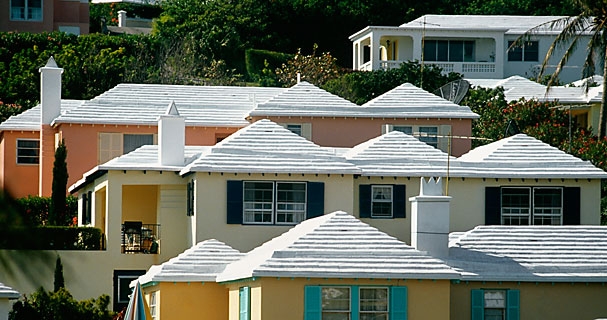forum
library
tutorial
contact

White Roofs Would Offset Warming,
Researchers Say
by Margot RooseveltLos Angeles Times, September 14, 2008
|
the film forum library tutorial contact |

|
White Roofs Would Offset Warming,
by Margot Roosevelt |
 Builders have known for decades that white roofs reflect the sun's rays and lower the cost of air conditioning. But now scientists say they have quantified a new benefit: slowing global warming.
Builders have known for decades that white roofs reflect the sun's rays and lower the cost of air conditioning. But now scientists say they have quantified a new benefit: slowing global warming.
If the 100 biggest cities in the world installed white roofs and changed their pavement to more reflective materials - say, concrete instead of asphalt-based material - the global cooling effect would be massive, according to data released Tuesday at California's annual Climate Change Research Conference.
Since 2005, California has required that flat commercial structures have white roofs. Next year, new and retrofitted residential and commercial buildings, with both flat and sloped roofs, will have to install heat-reflecting roofing, as part of an energy efficient building code.
But the state has yet to pass any rules to encourage cooler pavement on its roads, which are largely coated with heat-absorbing asphalt, a cheap byproduct of oil refining.
According to Hashem Akbari, a physicist with the Lawrence Berkeley National Laboratory, a 1,000-square-foot roof - the average size on an American home - offsets 10 metric tons of planet-heating carbon dioxide emissions in the atmosphere if dark-colored shingles or coatings are replaced with white material.
Globally, roofs account for 25 percent of the surface of most cities, and pavement accounts for about 35 percent. If all were switched to reflective material in 100 major urban areas, it would offset 44 metric gigatons of greenhouse gases, which have been trapping heat in the atmosphere and altering the climate on a potentially dangerous scale.
That is more than all the countries on Earth emit in a single year. And, with global climate negotiators focused on how to offset a rapid growth in emissions, installing cool roofs and pavements would account for more than 10 years of emissions growth, even without slashing industrial pollution.
Akbari's paper, "Global Cooling: Increasing World-wide Urban Albedos to Offset CO2," to be published in the journal Climatic Change, was written with his colleague Surabi Menon and University of California, Berkeley physicist Arthur Rosenfeld, a California energy commissioner. All three have been associated with the laboratory's Heat Island Group, which has published extensive research on how roofs and pavement raise urban temperatures.
Akbari and Rosenfeld said they will mount an effort to persuade the United Nations to organize major cities to alter their roofing and pavement. "I call it win-win-win," Akbari said. "First, a cooler environment not only saves energy but improves comfort. Second, cooling a city by a few degrees dramatically reduces smog. And the third win is offsetting global warming."
From Why the 2008 FCRPS Biological Opinion Does Not Include Removal of the Four Lower Snake River Dams by NOAA Fisheries, FCRPS Biological Opinion, 5/5/8The lower Snake River dams generate 1,022 average megawatts of emissions-free electricity per year, enough to power the city of Seattle. According to a 2007 study conducted by the Northwest Power and Conservation Council (NPCC 2007), removing the dams and replacing the power with the most likely fossil-fuel resource, would add 5.4 million tons of carbon dioxide (NPCC 2007 actually reported 4.4 million tons) every year to the region's air, contributing to the atmospheric carbon dioxide burden and possibly influencing climate change. The Council concluded that meeting the region's carbon reduction goals will be very challenging and that removing the lower Snake River dams would be "counterproductive."
NPCC 2007 states "Replacement of the power lost by breaching the lower Snake River dams by increased acquisition of conservation and renewable energy could, at least in the near term, delay some of the CO2 impacts of dam breaching. However, tying the increased development of conservation and renewables to dam breaching is misleading. If additional conservation and renewables are available and desirable, they should be pursued as part of a regional strategy to reduce CO2 emissions."
bluefish does the math: From article above, "a 1,000-square-foot roof - the average size on an American home - offsets 10 metric tons of planet-heating carbon dioxide emissions in the atmosphere if dark-colored shingles or coatings are replaced with white material."
Fossil-fuel replacement of 4 Lower Snake River dams would add 4.4 million tons CO2/year.
393,000 average sized American homes converted to white roofs would offset 4.4 million tons of C02.
learn more on topics covered in the film
see the video
read the script
learn the songs
discussion forum
